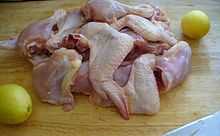Poultry

Poultry is a category of domesticated birds kept by humans for the purpose of collecting of their eggs, or killing for their meat or feathers. These most typically are members of the superorder Galloanserae (fowl), especially the order Galliformes (which includes chickens, quails and turkeys) and the family Anatidae (in order Anseriformes), commonly known as "waterfowl" (e.g. domestic ducks and domestic geese). Poultry also includes other birds which are killed for their meat, such as pigeons or doves or birds considered to be game, such as pheasants. Poultry comes from the French/Norman word poule, itself derived from the Latin word pullus, which means small animal.
Poultry is the second most widely eaten meat in the world, accounting for about 30% of meat production worldwide, after pork at 38%.[1]
Examples
| Bird | Wild ancestor |
|---|---|
| Chicken | Red Junglefowl |
| Duck | Muscovy Duck/Mallard |
| Emu | Emu |
| Goose | Greylag Goose/Swan Goose |
| Indian peafowl | Indian Peafowl |
| Mute swan | Mute Swan |
| Ostrich | Ostrich |
| Pigeon | Rock Dove |
| Turkey | Wild Turkey |
| Guineafowl | Helmeted guineafowl |
| Common Pheasant | Common Pheasant |
| Golden Pheasant | Golden Pheasant |
| Rhea | Rhea |
Cuts of poultry


The meatiest parts of a bird are the flight muscles on its chest, called breast meat, and the walking muscles on the first and second segments of its legs, called the thigh and drumstick, respectively. The wings are also eaten, usually (in the United States) without separating them, as in Buffalo wings; the first and second segment of the wings are referred to as drumette (meatier) and wingette (or flat) when these need to be distinguished, though these are technical terms. In Japan, the wing is frequently separated, and these parts are referred to as 手羽元 (teba-moto "wing base") and 手羽先 (teba-saki "wing tip").
Dark meat, which avian myologists refer to as "red muscle," is used for sustained activity—chiefly walking, in the case of a chicken. The dark color comes from the protein myoglobin, which plays a key role in oxygen uptake within cells. White muscle, in contrast, is suitable only for short, ineffectual bursts of activity such as, for chickens, flying. Thus the chicken's leg and thigh meat are dark while its breast meat (which makes up the primary flight muscles) is white. Other birds with breast muscle more suitable for sustained flight, such as ducks and geese, have red muscle (and therefore dark meat) throughout.
Health
Chicken meat contains about two to three times as much polyunsaturated fat as most types of red meat when measured by weight.[2] However, for boneless, skinless chicken breast, the amount is much lower. A 100g serving of baked chicken breast contains 4 grams of fat and 31 grams of protein, compared to 10 grams of fat and 27 grams of protein for the same portion of broiled, lean skirt steak.[3][4]
A recent study by the Translational Genomics Research Institute showed that 47% of the meat and poultry in U.S. grocery stores were contaminated with S. aureus, and 52% of those bacteria were resistant to antibiotics.[5]
See also
- Amenable species
- Chicken (food)
- Domestic turkey
- Duck (food)
- Oyster (fowl)
- Poultry farming
- Pollotarianism
- Roast goose
- Squab (food)
References
- ↑ Raloff, Janet. Food for Thought: Global Food Trends. Science News Online. May 31, 2003.
- ↑ "Feinberg School > Nutrition > Nutrition Fact Sheet: Lipids". Northwestern University. Archived from the original on 2011-07-20. Retrieved August 24, 2009.
- ↑ Nutrition Data - 100g Chicken Breast
- ↑ Nutrition Data - 100g Lean Skirt Steak
- ↑ US Meat and Poultry Is Widely Contaminated With Drug-Resistant Staph Bacteria
External links
- Information on Poultry Diseases
- PoultryCast podcast
- PoultryHub.org is a wiki-based collaborative resource centre where people share information about poultry
- The Poultry Guide - A to Z and FAQs
- World Poultry.net - all you need to know about poultry
- ChickenCrossing.Org - Information,discussion, links about chickens & other poultry
- Poultry.ie - Irish Poultry Community and Information Source